diffusion by immigration, conversion, missionaries

|
|
|
Table of Contents
What Is Culture?
To the social scientist, culture is the specialized behavioral patterns, understandings, adaptations and social systems that summarize a people’s way of life.
culture is shaped by environment: rain was a tool of God's wrath to the Hebrews, but sacred to the Anastazi culture is shaped by social organization: the more advanced a society, the more organized it is culture is shaped by values and beliefs: Aztec flower wars, cannibals culture is learned behavior: sports, kissing
Culture includes the visible (buildings) and the invisible (language), the material (cultural landscape) and the internal (religion).
Seven Major Traits of Culture1. Learned
a. Learned through interaction, observation, and imitation b. Conscious: being told, reading c. Unconscious: most culture is learned unconsciously, i.e. through language for example d. Learned from a variety of sources 1. Proverbs 2. Folk tales and folklore 3. High Culture: poetry, art, music 4. Mass media (especially TV in this generation) 2. Transmitted
3. Based on Symbols
4. Changeable
Changes occurs from: a. innovation (discovery) e.g. television, computer, women’s movement b. diffusion (borrowing) e.g. McDonalds worldwide c. acculturation (long-term contact with another culture) e.g. Taco Bell? 5. Integrated
6. Ethnocentric
7. Adaptive
Definition Of Culture
|
|
Time |
Hunting and Gathering |
Agricultural |
Industrial |
Post-industrial |
|
~8,000 BC |
~8000 BC – ~AD 1750 |
1750s – 1970s |
1970s -- Present | |
|
Economy |
Hunting and gathering |
Slash and burn Livestock domestication trade |
Industrialization Transportation International trade |
Services |
|
Social Structure |
Subsistence egalitarian |
Surplus Social divisions Civilization |
Commercialization Capitalism |
Global culture? Consumption |
|
Population |
Small groups Low density |
Expanding Increase in density |
Growing High concentration |
Slow growth Aging |
|
Geography |
Mobile Temporary settlements |
Low mobility Permanent settlements Cities |
Migration Rapid urbanization Large metropolitan regions |
International migration Highly urbanized |
|
Examples |
Kungl Penan |
Mesopotamia China |
Britain |
US |
Cultural change is constant.
Cultural change can be both major and minor.
Cultural change is brought about by:
o innovation
o spatial diffusion
o acculturation
...ideas or technology created within one group and adopted by the larger culture
All cultures have some innate resistance to change.
However, when a social group is especially unresponsive to innovation it exhibits cultural lag.
It is not always clear or certain whether the existence of a cultural trait in two different areas is the result of diffusion.
In some cases independent (or parallel) invention has occurred … example: pyramids

they are not the same
culture is learned
ethnicity is race (biology)
the same ethnic group can be divided culturally:
o In Rwanda: Hutus and Tutsis are of the same ethnic group but they are different cultural groups.
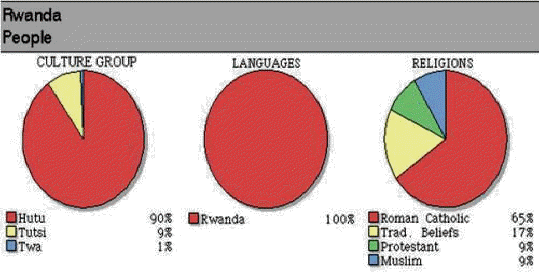
o In Bosnia, the Serbs, Croats and Muslims are all from the same Slavic ethnic group but they are different cultural groups. For example, they speak different languages and practice different religions.
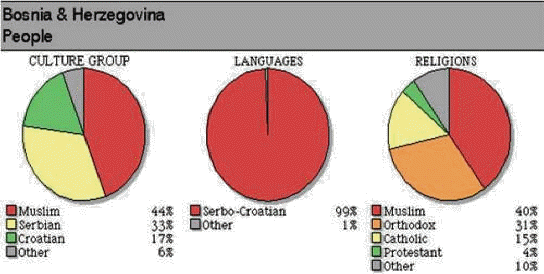
So-called ethnic conflicts are usually cultural conflicts. Often they are not between different races, but rather between different cultural groups.
...the fragmentation of a region into smaller, often hostile, political units … usually results in a new independent state [Term comes from the Balkan Peninsula of Europe, a region that has balkanized many times and is still undergoing balkanization.]
Examples: Yugoslavia, USSR, East Timor
Unsuccessful Attempts: Kashmir, Sri Lanka, Kurdistan, Catalonia
...the process by which regions within a state demand and gain political strength and growing autonomy at the expense of the central government … results in increased autonomy for a region (If strong enough, these devolutionary pressures may result in balkanization.)
Examples: Quebec, Indian Reservations in the US, Scotland, Chechnya in Russia (changing)
...those forces from within a state that tend to divide it … causes of conflicts within a state
Memory Hint: centrifugal = go apart
Examples: religion, language, ethnicity, ideology
...those forces from within a state that unite it … forces that keep a country together
Memory Hint: centripetal = pull together
Examples: a strong common culture, religion, language, history, a popular national hero, a common outside threat, colonialism, an historical enemy
...a policy of cultural extension and potential political expansion aimed at a national group living in a neighboring country … for example, when India mistreated Muslims living in the Indian states of Jammu and Kashmir, the Muslim government of neighboring Pakistan threatened and ultimately went to war.
Irredentism is often a cause of cultural conflicts as countries protect members of their cultural group living in neighboring countries.
Examples: the Marsh Shiites, Armenians in Azerbaijan, Muslims in Kashmir, Serbs in Bosnia, Somalis in Ethiopia and Kenya, Afghanis in Pakistan
Solutions: relocate borders, resettle population, devolution / autonomy
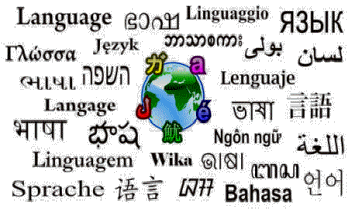

Language is a fundamental strand in the complex web of culture serving to shape and distinguish people and groups.
Languages are constantly changing.
Languages evolve in place; responding to changes and borrowing from other languages.
Languages disperse … carried by migrants, colonizers and conquerors.
Language is an organized system of spoken words by which people communicate with each other with mutual comprehension. This definition fails to recognize the gradations among and between languages or the varying degrees of mutual comprehension between two or more languages.
Some estimates place the number of languages spoken around the world at 4000 to 6000.
Although this seems like a lot, we estimate that up to 15,000 languages were spoken in the past.
Cultural convergence: More than half of the world’s inhabitants speak just eight languages.
...a group of languages descended from a single earlier tongue
Latin: Romance Languages
We can trace Latin, Germanic, Celtic and Slavic (and other) languages further back to a larger family of languages known as the Indo-European Language Family.
About half of the world speaks a language from the Indo-European Family of Languages.
 World Pattern of Languages
World Pattern of LanguagesThe present world distribution of languages cannot show much of the details, but gives an overall view.
Languages are dynamic and some have spread throughout the world from their place of origin.
Indo-European Languages
Amerindian (Asian) Languages
Bantu and Khoisan Languages
Arabic Language
Language can spread through each type of spatial diffusion.
Relocation: English, Bantu
Expansion: Latin, Arabic
Hierarchical: English in India
Most languages spread through adoption rather than eviction of other languages.
Language can be affected by the presence or absence of diffusion barriers.
Physical Diffusion Barriers
Pyrenees (Basques)
Caucasus Mountains (Slavic and Ural-Altaic)
Cultural Diffusion Barriers
Greeks
Celtics
Languages constantly change and these changes may not always be noticeable over a lifetime, but can be significant over longer periods of time.
Shakespeare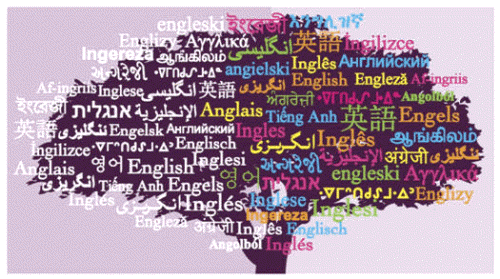
King James Bible
Change can be gradual or abrupt.
In the case of the English language:
Norman Conquest (10,000 new words)
From 1558 to 1625 (12,000 new words)
New World (200 new words)
Scientific research, computers, business and the internet are constantly adding new words.
The Story of English
English is a product of change starting with proto-Germanic dialects and other dialects brought by different conquerors (Danish, Angles, Saxons, etc.). Earlier Celtic-speaking people were displaced to the north and west. The Norman Conquest brought more change along with the adoption of French by the nobility. Within 400 years English has developed from a localized language of 7 million islanders to an international language.
400 million speakers
400 million know it as a second language
300 to 400 million who can communicate in English
English is the official language of 60 countries … more than French, Arabic or Spanish.
The spread of English as a worldwide language was the result of the establishment of overseas colonies and the former English dominance in world trade.
Standard and Variant Languages
People who speak a common language, such as English, are members of a speech community which possesses both a standard language … comprised of the accepted forms of syntax, vocabulary and pronunciation and also of dialects.
Standard Language
At some point in the development of a language one of the dialects becomes accepted as the standard language.
French: Paris
Russian: St. Petersburg and Moscow
Chinese: Mandarin dialect of Beijing
English: Oxford English
Dialects
All languages display recognizable speech variants -- vocabulary, pronunciation, rhythm -- which are called dialects.
Dialects can become so different that people using the standard language will have trouble understanding other dialects.
Isolation can preserve dialects.
Dialects in America
As early as the 1700s there were three distinctive dialects that developed along the East Coast in America.
These dialects then spread westward along with migrants.
The patterns we see are related to the migration patterns of these people.
Pidgins
A pidgin is a combination of two languages -- usually a simplified form of one -- so that people speaking two different languages can communicate with each other.
A pidgin is not the first language of either speaker.
Creole
If a pidgin becomes a first language for a group of people -- who may have lost their former language through disuse -- a Creole has evolved.
Haitian Creole
Swahili -- Bantu
Afrikaans -- Dutch
A pidgin is not a Creole, but a Creole can evolve from a pidgin and in the process develop a more complex grammatical structure and enhanced vocabulary.

...an established language used for communication between groups of people who speak different languages
Greek
Latin (Latin Quarter)
Arabic (Muslim)
Mandarin Chinese
Hindi
English
...a country’s required language of instruction in schools, government, business, law and other official functions
Language is a very important part of any culture.
Recently many countries in Europe -- for example, France and Wales -- have relaxed the use of the official language or standard dialect.
Does the US have an official language?
Toponymy is the study of place names.
place names: language on the landscape, a record of past inhabitants


Religion is a personal or institutional system of worship and faith in the sacred or divine.
It's difficult to define exactly what a religion is, because religion manifests itself in so many different ways. Organized religion has powerful effects on human societies. It has been a major force in combating social ills, sustaining the poor, educating the deprived and advancing medical knowledge. However, religion has also blocked scientific study, supported colonialism and exploitation, and condemned women to an inferior status in many societies. Even where religion is less dominant, its expression is still evident in many practices and beliefs.
Religion, like language, is a symbol of group identity. The role of religion can vary in culture, dominating among some and unimportant or denied in others.
Non-religious value systems -- Humanism or Marxism -- can be just as binding or important to some people or cultures.
|
religion |
origins |
diffusion |
type and distribution |
characteristics |
landscape |
|
Christianity |
Jerusalem (2000 years ago) |
diffusion by missionaries, trade, colonization, globalization |
universalizing |
monotheistic hierarchical relationship between people and nature |
churches: urban location and center of town |
|
Catholicism (largest) |
continuation of the early Christian community established by Jesus Christ |
diffusion by missionaries, exploration, colonization, conquest |
S America S Europe |
infallibility of the Pope less emphasis on scriptures omnipotent Triune God emphasis placed on saints with special status of Mary Christ: son of God all are sinners and can only be saved by grace through church ritual |
authority of the church lies within the hierarchy of the church churches: elaborately decorated, higher, spacious |
|
Protestantism |
Germany formed from split with Roman Catholicism during the Reformation in the 16th century |
diffusion by immigration, conversion, missionaries |
N America N Europe |
priesthood of the believers scriptures: final authority in Christian doctrine omnipotent Triune God, existence of angels and devil Christ: son of God all are sinners and can only be saved by grace |
churches: less decorated, most are modest in size to varying degrees maintained or rejected Roman Catholic forms of worship |
|
Orthodoxy (Eastern Orthodox, Oriental Orthodox, Orthodox) |
continuation of the early Christian community established by Jesus Christ, especially as it developed within the Greek-speaking eastern branch of the Roman Empire |
diffusion by immigration, conversion, missionaries
|
Russia E Europe |
follow beliefs and practices defined by first seven ecumenical councils (dating back to the first ten centuries) more inclined toward philosophy, mysticism, and ideology less emphasis on scriptures omnipotent Triune God Christ: son of God |
veneration of icons and a mystical form of meditative prayer worship: highly liturgical and extremely iconographic churches tend to be more elaborate |
|
Islam |
Medina and Mecca (1,300+ years ago) |
diffusion by trade and military control rapid growth |
universalizing |
five pillars of Islam Islamic law: no codified laws per se, but rather various schools of law centrality of the Quran, the Prophet's hadith (sayings) and the sunna, or customs Christianity and Judaism are "People of the Book" |
mosque: place of worship and community center Mecca: Holy City |
|
Sunni Muslim (largest) |
Original split occurred after death of Muhammad, in 632 over dispute among Muslims in present-day Saudi Arabia over the question of succession. Most wanted the community of Muslims to choose a caliph to succeed him (Sunnis) but a smaller group (Shia) thought someone from his family should succeed (Ali, who was married to Muhammad's daughter, Fatimah). Split was violent but over the centuries have lived peacefully together for long periods of time. |
diffusion by conquest, trade, missionaries |
Middle East N Africa Asia majority in most Muslim countries |
rightly-guided caliphs authoritative revelation ended with Prophet Muhammad doctrine is more rigidly aligned in accordance with the various schools but its hierarchical structure is looser and often falls under state, rather than clerical, control |
All mosques, no matter their affiliation with Sunni or Shia Muslims, generally have a similar physical set up, and universally contain a niche on the wall called a mirhab that points worshipers toward the direction of Mecca. |
|
Shiite Muslim |
diffusion by conquest |
Iran and Iraq, Yemen, Bahrain, Azerbaijan, Lebanon minority spread across the world |
infallible imams - continuation of authoritative revelation imams have taken on a spiritual significance that no clerics in Sunni Islam enjoy God took 12th imam (known as the Mahdi or Messiah) into hiding, and he will come back at the end of time the full word and meaning of the Quran and the Prophet Muhammad's message will only be made manifest, or real and just, upon the return of the 12th Imam |
build and visit shrines |
|
|
Buddhism |
Ganges Plain (2,500+ years) Buddhism, in its origin at least, is an offshoot of Hinduism, reaction to the less desirable features of Hinduism such as its strict social hierarchy. spread from India to South, East and Southeast Asia |
diffusion by relocation, missionaries (monks and emissaries), trade from India to E and SE Asia |
universalizing |
Siddhartha
was meditating under a tree when he was balanced relationship with nature don't believe in an absolute entity / supreme being common basic teachings of Four Noble Truths, Eight fold path |
temples: rural location, visited only occasionally pagodas |
|
Theravada |
schism after first council on death of the Buddha over monastic rules and academic points such as whether an enlightened person could lapse or not |
South: Sri Lanka, Thailand, Burma, Lao, Cambodia, parts of SE Asia, S Asia, Australia, North America |
"teaching of the elders": refers to pure or original teachings of the Buddha 2,500+ years ago, pre-Buddhist Indian influences no concept of sin, all deeds are volitional and have their fruits abstain from all kinds of evil, accumulate all that is good and purify our minds through ethical conduct, meditation and insight-wisdom intense, dedicated, time-consuming effort required to attain enlightenment, strives for wisdom first |
there is no worship but there are monastic temples statues are used for meditation and prayers few rituals, not emphasized politically conservative |
|
|
Mahayana (largest) |
North: Tibet, China, Taiwan, Korea, Japan, Mongolia, parts of SE Asia, Australia, North America |
"great vehicle": more of an umbrella body for a great variety of schools, heavily influenced by local religious ideas as transmitted to new cultures practices: meditation, regular visits to temples to make offerings to the Buddha enlightenment achieved through normal life with spiritual involvement, strives for compassion first |
worship in temples and monasteries statues are used for meditation and prayers many rituals owing to local cultural influences politically liberal |
||
|
Hinduism |
Punjab (4,000 years ago)
one of the
world’s oldest religions - no identifiable |
diffusion by conversion, trade, relocation
Did
not spread much because Hindus |
ethnic (India, Nepal, SE Asia) spread from N India to the Indian sub-continent focused in India and SE Asia
|
diverse practices: no unified system of beliefs and ideas, religion and culture nearly interchangeable in Hinduism understanding Brahma (existence) from within the Atman (self or soul) attaining the highest life is a process of removing bodily distractions from life moral ideals: non-violence, truthfulness, friendship, compassion, fortitude, self-control, purity, generosity polytheistic: many gods, but they all come from Atman reincarnation: constant cycle of reincarnation until enlightenment is reached caste system |
temples (mandir) and shrines to many gods no official clergy idol worship statues used as meditation objects holy animals endless processions and rituals sacred space: Ganges River |
|
Judaism |
Jerusalem (~3,500 years) Abraham considered father of Jewish people |
diffusion by relocation due to political and religious persecution Someone not born a Jew can convert to Judaism, but it is a difficult process. Jews believe that a Jew is someone who is the child of a Jewish mother. |
ethnic Israel, parts of US and Europe |
first monotheistic religion, omnipotent God with whom every Jew can have an individual and personal relationship no official creed used to describe a race and culture, as well as a religion covenant relationship: doing things in the way that pleases God is an act of worship, try to bring holiness into everything they do God appointed the Jews to be his chosen people in order to set an example of holiness and ethical behavior. a faith of action: people should be judged not so much by the intellectual content of their beliefs but by the way they live their faith sacred text: the Tenakh, legal books, written by rabbis, determine the law as it applies to life |
synagogue: place where Jews come together for community prayer structures not necessary Jerusalem, Holy Land shul: emphasizes synagogue's role as a place of study, study of sacred texts is a life-long task temple: consider every meeting place to be equivalent to, or replacement for, the Temple in Jerusalem |
|
Animism |
varied in origins We have seen evidence of animism in groups as far back as 10,000 BCE but because animism is characteristic of many indigenous religions, its sources lay in many times and places. |
diffusion by relocation (minimal) |
tribal / ethnic N Canada, S America, Sub-Saharan Africa, S Pacific. |
belief system of some indigenous tribal peoples, especially prior to the development of organized religion worldview that non-human entities - such as animals, plants inanimate objects, even words - possess a spiritual essence belief in innumerable spiritual beings concerned with human affairs and capable of helping or harming human interests many different practices: reflect the geographic environment, spiritual cultural history and distinct worldview of the groups who practice its various expressions examples: shamanism, neo-paganism, totemism, Ojibwe concept of personhood, Munism of the Lepcha, Voudon, Australian Aboriginals |
natural objects are sacred and respected no specific religious sites of worship for all holds nature in the highest regard Structures are generally very old and made of stone. Holy places derive from the distinctive physical environment, such as mountains, rivers or rock formations. |
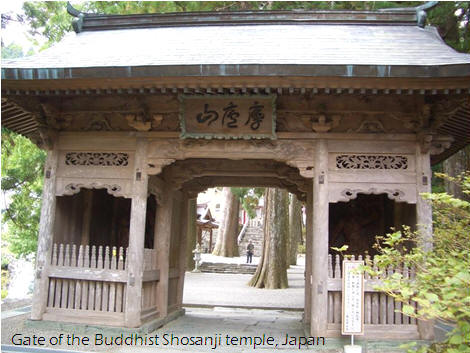
Religions can leave an imprint on the cultural landscape.
Buildings
Cemeteries
Monotheism is the belief in a single deity or god.
Polytheism is the belief in many gods.
Neither of these classifications is particularly spatially relevant.
Geographers focus on the patterns and diffusion of religions.
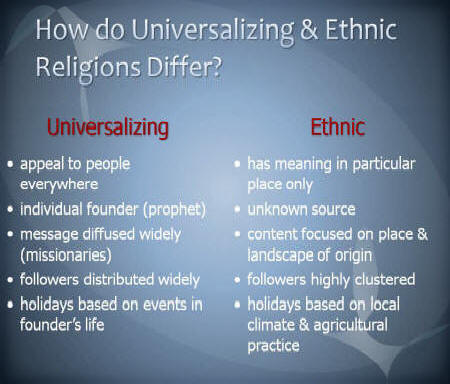 Universalizing Religions
Universalizing Religions
...claim applicability to all humans and seeks converts … it has open membership and no one is excluded because of nationality, ethnicity or previous religious belief
Christianity, Islam and Buddhism are examples of universalizing religions.
Universalizing religions tend to expand.
More than half of the world adheres to the major universalizing religions.
Ethnic Religions
...have strong territorial and cultural group identification
Membership is by birth or by the adoption of a complex lifestyle … not by a simple declaration of faith. (Do not seek converts.)
Judaism, Hinduism and Shinto are examples of ethnic religions.
Ethnic religions tend to be regionally confined.
Tribal or Traditional Religions
...special forms of ethnic religions distinguished by their small size and close ties to nature
Animism is the belief that life exists in all objects.
Shamanism involves the community acceptance of a shaman who interprets the spirit world.
Tribal religions tend to contract and become incorporated into other religions.
Secularism
...an indifference or rejection of religion and religious belief
Secularism is an increasing part of many modern societies … particularity of industrialized nations.
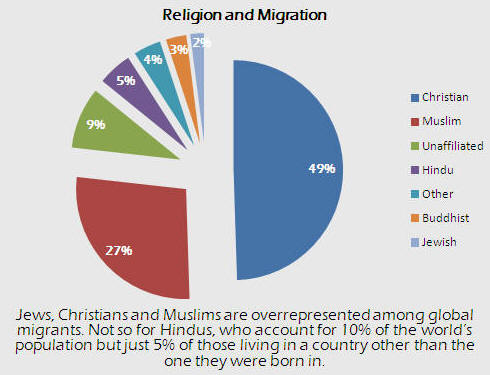

Most migration decisions are based on economic opportunity; real or perceived.
Other factors can include:
Climate
Safety
Schools
Many times the decision to migrate is based on perception more than reality. Individual migration decisions are based on push and pull factors.
Push factors: negative home conditions impel people to migrate, push them away
Pull factors: perceived attractions of another location, pull them to come
Place Utility is the measure of an individual’s satisfaction with a given location ... The potential migrant considers not only the place utility of his present location, but also the expected place utility of potential destinations.
Migration Fields are the areas from which a given city or place draws the majority of its in-migrants.
Forced Migrants Reluctant Migrants
African Slaves Refugees
Native Americans Bosnians
Convicts
There are several different ways that people can migrate including:
Step migration: step by step transition usually from a smaller place to a larger place
Chain migration: the process by which migration movements from a common home area to a specific destination are sustained by links of friendship or kinship between first movers and later followers
Counter migration: the return of migrants to the regions from which they earlier emigrated
Global International Migration Flows.
The Global Migration Group (GMG
Pew Research Center Migration Center
Population Reference Bureau Immigration Center
Cool Maps' Global Trends in Migration Interactive Map
MacArthur Foundation Global Migration Program
The Many Faces of Global Migration from Gallup

 North America is a composite of many ethnic groups.
Increasingly that is the case for the whole world.
North America is a composite of many ethnic groups.
Increasingly that is the case for the whole world.
The multiple movements, diffusions, migrations and mixings of people of different origins are the subject of ethnic geography.
Even the most seemingly homogenous countries are home to distinctive groups.
...a term derived from the Greek term ethnos, meaning a people or nation. No single trait denotes ethnicity … group recognition may be based on language, religion, national origin or unique customs. Ethnicity is a spatial concept and ethnic groups are associated with clearly recognized territories.
Ethnocentrism is the term describing a tendency to evaluate other cultures against the standards of one’s own. This sometimes leads to a feeling of superiority of one’s ethnic group or culture over another.
Ethnic Groups and Conflict
Many times the mixing of ethnic groups produces conflict.
Africa
urban areas
Yugoslavia
Afghanistan
The host society is the established and dominant society within which immigrant groups seek accommodation.
When an immigrant group adopts cultural and social modifications that permit it to operate effectively within its new social surroundings, the process is known as acculturation.
Assimilation is when an individual or minority group has greatly reduced or loses completely its identifying traits and blends into the host society. Assimilation does not necessarily mean that ethnic consciousness or awareness is lost. Many times ethnic consciousness is revived by the group most assimilated.
Culture rebound is the re-adoption of culture traits and identities associated with your ethnic forebears or ancestral homelands.
Culture Transfer: When immigrants arrive in a new location they bring their culture with them. How much is kept depends on the circumstances.
Germans
Hmong
Mormons
In North America everyone is technically a migrant. If we look at the relatively recent (last 500 years) immigration to North America we can break it down to three major waves.
In 1920 13% of the US population was foreign born.
In 1970 only 4.8% was foreign born.
By 1990 8.8% was foreign born.
Immigration accounts for about 30% of population growth in the US.
First Immigration Stream
from beginning of pioneer settlement to about 1870
mostly Northwestern Europe (English, German, Irish Scotch-Irish, Welsh) and African (About 20% in 1790)
source area of the majority of the migrants changed
Second Migration Stream
from 1870 to 1921
made up of mostly migrants from eastern and southern Europe (Poles, Italians, Slavs, Jews and Scandinavians)
ended with new immigration laws
Third Immigration Stream
started in the 1960s with changes in the immigration laws and continuing to present
composed of mostly Hispanics and Asians
Whenever an empty territory undergoes settlement or an earlier population is dislodged by invaders, the specific characteristics of the first group able to effect a viable, self perpetuating society -- the charter group -- are of crucial significance for the later social and cultural geography of the area, no matter how tiny the initial band of settlers may have been.
Wilbur Zelinsky termed the imprint left by the charter group as the doctrine of first effective settlement.
The English became the charter group for most of North America establishing the cultural norms and standards.
In eastern Canada the French were the charter group.
In the southwestern US the Spanish were the charter group.

Many ethnic groups that came to urban areas in the US moved to ethnic enclaves. (chain migration)
Some ethnic groups that moved to rural areas created ethnic islands. (cluster migration)
Some entire regions of North America have become associated with certain ethnic groups.
French
African Americans
Native Americans
Hispanics
African American Migrations
During the 20th century many African Americans moved from the South to urban areas in the North ... over 5 million from 1940 to 1970 alone.
Changes in technology (share cropping)
Industrial opportunities
Starting in the 1970s there has been a major counter-migration.
Hispanic Migrations
Hispanics are the fastest growing minority group, soon to pass African Americans.
Diverse group
Mexicans (60% of all Hispanics)
Puerto Ricans (NYC, Philadelphia, MA, CO, NJ)
Cubans (Miami)
Dominicans (NYC)
Hondurans (New Orleans)
Chain Migration
Asian Migrations
The rapid growth of Asian Migration is due to:
The change in the immigration laws (chain migration)
Refugees from the Vietnam Conflict
Most Asians migrate to the West (59%) with 40% residing in California.
Diverse
Vietnamese (Orange County)
Hmong (Minneapolis)
Koreans (26% in Koreatown)

Immigrant neighborhoods are a measure of the social distance that separates the minority from the charter group.
Segregation is the extent to which members of an ethnic group are not uniformly distributed in relation to the rest of the population.
The rate of assimilation of ethnic groups is dependent on both external and internal controls.
External Controls: Groups on the edge of an ethnic enclave will use blocking tactics to keep that group out of their neighborhood.
Tipping point
Internal Controls
The self-elected segregation of ethnic groups serves four functions including:
Defense (reduces exposure-familiar)
Support (language, jobs, relatives)
Preservation of the culture (diet, marriage)
Attack (voting and political representation)
While an ethnic cluster endures it may be termed a colony or point of entry, many times dispersing after assimilation.
When an ethnic cluster persists because the occupants keep it intact the area is considered an ethnic enclave.
When the cluster is perpetuated by external forces and discrimination it is a ghetto.
Ethnic neighborhoods are not always permanent.
Los Angeles
Philadelphia
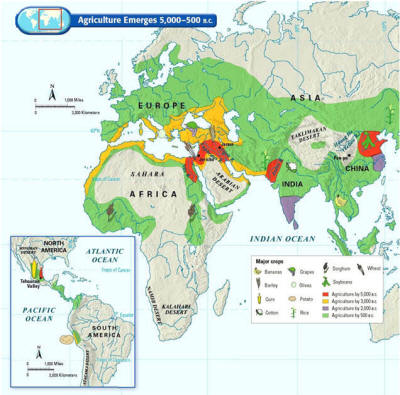

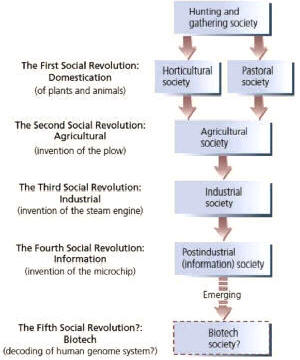 Agriculture: defined as the growing of crops and the tending of livestock
whether for subsistence or commercial reasons, has replaced hunting and gathering as the most significant of the primary economic activities.
Agriculture: defined as the growing of crops and the tending of livestock
whether for subsistence or commercial reasons, has replaced hunting and gathering as the most significant of the primary economic activities.
In developing areas farming is 75-90% of the labor force. In developed areas, it is 10% or less.
...consists of any agricultural economy in which the crops and/or animals are used nearly exclusively for local or family consumption
In most of Africa, Asia and much of Latin America, a large percentage of people are primarily involved with feeding themselves from their own land and livestock.
Two types of subsistence agriculture are recognized: extensive and intensive. Although each type has several varieties, the essential contrast between them is yield per unit of area used.
Extensive subsistence agriculture involves large areas of land and minimal labor input per acre. Both product per land unit and population densities are low.
Intensive subsistence agriculture involves the cultivation of small parcels of land through the expenditure of great amounts of labor per acre. Yields per unit area and population densities are high. Intensive subsistence agriculture involves the cultivation of small parcels of land through the expenditure of great amounts of labor per acre. Yields per unit area and population densities are high. The major crops produced are rice, wheat, corn, millet and pulses (peas and beans). Most of these people live in monsoon areas of Asia and rice is the major crop which under ideal conditions can provide high yields per unit of land.
Urban subsistence agriculture is an important part of food production in urban areas of the least developed parts of the world.
Positive: more food on marginal land using (recycling) garbage, human wastes.
Negative: environmental/degradation (water supplies) and health problems (spread of disease) from indiscriminant use of fertilizers (human waste) and pesticides/herbicides.
...the wandering, but controlled movement of livestock, solely dependent on natural forage, the most extensive type of land use system
Sheep and goats are the most common with cattle, horses and yaks locally important. The common characteristics are hardiness, mobility and ability to subsist on sparse forage. These animals provide milk, cheese, meat, hair, wool, skins and dung (for fuel).
Declining in numbers (Russia and The Sahel)
Another form of extensive subsistence agriculture is found in the tropical rainforest areas where people engage in a kind of nomadic farming. This shifting cultivation is called swidden or slash and burn. In these areas, the soils have little ability to hold nutrients because of the large amounts of rain.
The trees and brush are hacked down and burned, and these areas are planted with corn, millet, rice, manioc, yams and sugar cane. Then the field is moved to another area and the plot is allowed to re-vegetate. More and more commercial crops such as coffee are grown as a cash crop.
Initial yields are high, but drop off as the nutrients are used or washed away. Productivity is maintained by rotation of plots rather than crops. Problems include declining soil fertility and population pressures.
Nearly 5% of the world’s population and 1/5 of the world’s land area are predominantly engaged in tropical shifting agriculture.
Rapidly growing populations have led to more and more intensive, extensive and exhaustive use of land for agriculture. When population pressures dictate land conversion, serious environmental deterioration may result.
Tropical rain forests
Semi-deserts
Increased productivity of existing cropland rather than expansion of cultivated area has accounted for most of the growth of food production over the past few decades.
The Green Revolution is a shorthand reference to a system of seed and management (fertilizer and pesticide/herbicide) improvements adapted to the needs of intensive agriculture that have brought larger harvests from a given parcel of farmland.
Between 1965 and 1995, world cereal production rose 90%. The increase was due to increases in yields rather than expansion of cropland. Harvests have risen dramatically. Genetic improvement in rice and wheat has formed the basis of the Green Revolution.
Negative Aspects Of The Green Revolution
Irrigation has mined water and destroyed some soils through salinization.
Less genetic diversity
Industrialization of farming
Very energy intensive
Only the most developed parts of the world can afford this type of agriculture.
In the most developed areas of the world, agriculture is managed like an industry … the farm is a factory that must turn out consistent products that can be processed efficiently.
Intensive commercial agriculture is practiced in areas where large amounts of capital (machinery, fertilizers) and/or labor per unit of land are used with the crops being sold in the market place. Often called truck farms (fruits, vegetables and dairy products)
Extensive commercial agriculture is characterized by low amounts of labor (highly mechanized) per unit of land area and is practiced further from markets on less expensive land. Typified by wheat (grain) farming and livestock raising.
Special circumstances, most often climatic, make some places far from markets intensively developed agricultural regions.
Mediterranean agriculture: grapes, olives, oranges, figs, vegetables ... these crops need warm temperatures all year long … winter rain, summer dry, irrigation
These are some of the most productive regions of the world.

...specialized crops usually native to the tropics in areas where the climate is conducive to these crops: coffee, sugar, cacao, tobacco, rubber, tea, bananas
Plantation crops are not for local consumption and are usually grown near coastlines to export.
In addition to agriculture other primary economic activities include fishing, forestry and mining of materials … The development of these primary activities is dependent on the occurrence of these resources (availability), the technology to exploit these resources and the cultural awareness of their value.
There are renewable and non-renewable resources.
Fishing and forestry are gathering industries based on the harvesting of renewable resources. In some cases, gathering can be extractive such that the renewable resource cannot recover.
The mining of minerals and mineral fuels is non-renewable.
The maximum sustainable yield of a resource is the maximum volume or rate of use that will not impair its ability to be renewed or to maintain the same future productivity.
The Tragedy of the Commons (3:19)
1832: William Forster Lloyd observed the devastation of common pastures and the puny and stunted draft animals that grazed on them.
1968: Garrett Hardin created the economic term tragedy of the commons.
The commons refers to any resource shared by a group of people.
Each household has the right to take resources from and put waste into the commons.
As the population grows, greed runs rampant and the commons collapses … the tragedy of the commons.
The plight of the commons in Lloyd's day is similar to the problems of over-fishing in our times.
Fish provide a significant amount (7%) of protein consumed by the world. Reliance on fish is greatest in developing countries of eastern and southeast Asia, Africa and parts of Latin America.
Almost all marine fishing is from the coastal areas. The wetlands, bays, estuaries, provide the nutrients from rivers and the spawning grounds for many species.
Both over-fishing and pollution have endangered the supply of the traditional and desired food species.
Aquaculture or fish farming is becoming more and more important.
Asian rice paddies
Catfish and crawfish (SE US)
Shellfish
Fish farming is now about 30% of the world’s fish harvest and is growing every year.
 Forestry
ForestryCommercial forests are restricted to two very large global belts.
the middle latitudes of the Northern Hemisphere
the equatorial zones of Central and South America, Central Africa and Southeast Asia
Two major uses of wood:
Industrial: paper, construction, furniture, 50% of all industrial wood harvested in US
Fuel: charcoal, heat, cooking; mostly in developing worlds, depleted at a rate above the maximum sustainable yield
Tropical lowland hardwood mostly cut down for fuel.
Mineral resources are not distributed evenly across the world. We have exploited the easiest ones.
Three types of minerals determined by geology: metallic minerals, non-metallic minerals and mineral fuels.
Metallic minerals: copper, iron, nickel, zinc, lead, etc. The metals market is highly volatile and driven by changes in supply and demand.
Non-metallic minerals: construction materials, gravel, building stone, gypsum and limestone for cement.
Mineral Fuels: also known as fossil fuels.
Coal: earliest in importance and still most plentiful of the mineral fuels … Supply measured in centuries.
Petroleum: most unevenly distributed of the major resources with 80% of known reserves in 8 countries. 2/3 of world’s total is in Arab states of Middle East.
30 to 70 years of known resources
Natural gas: called the nearly perfect energy resource. A highly efficient, versatile fuel that requires little processing and is environmentally benign.
50 years of known resources
[We'll take another look at primary industries when we look at economic geography.]
|
|